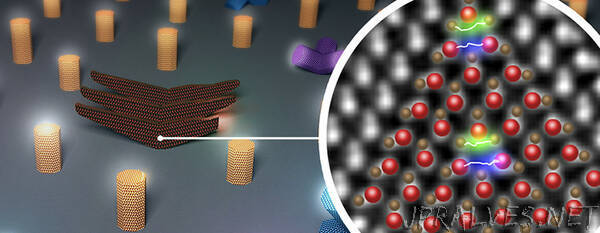
“A thorough study published on NanoLetters and led by the ICN2 Advanced Electron Nanoscopy group provides new insights on the growth mechanisms and conditions that determine the polarity of semiconductor nanostructures. Fine control of polarity can result in the design of new quantum devices.
Future applications of nanomaterials depend on our ability to understand their characteristics at the atomic scale and to modulate them at will. Polarity appears to play an important role in determining the physical and morphological properties of semiconductor nanostructures, thus researchers are studying how to control or change it.
Because of the way atoms are arranged in crystal structures, electromagnetic charges are locally separated. As a consequence, if we look at the crystal along specific directions, we can observe oppositely-charged ionic couples, which are called dumbbells because of their shape. Binary compounds – i.e. formed by two elements only – are said to have A- or B- polarity according to the dumbbell orientation. The type of polarity of these materials influences their properties, which, in turn, have a remarkable impact on the final applications.
An extensive study on polarity of semiconductor materials, conducted by Dr. María de la Mata, ICREA Prof. Jordi Arbiol and Sara Martí-Sánchez from the ICN2 Advanced Electron Nanoscopy group, in collaboration with researchers at the École Polytechnique Fédérale of Lausanne (Switzerland), the University of Bremen (Germany), the Nanyang Technological University (Singapore) and the Microsoft Quantum Lab of Delft (The Netherlands), has been recently published on NanoLetters.
Nanostructures of a wide range of semiconductor compounds have been grown in laboratory and then analyzed, using scanning transmission electron microscopy, in order to determine their polarity and compile a complete mapping. The researchers have observed that most of these materials spontaneously grow along the B-polar direction, while only a few follow either A- or B- polar directions. The latter are particularly interesting, as potentially they could offer us the possibility to predetermine their polarity during growth by intervening on some variables.
The aim of this study was indeed to pin down the factors that influence the polarity of non-planar nanostructures. Since, from the analysis of the new results and previously reported data, did not emerge any parameter that would relate the type of polarity with a specific family of binary compounds, it was concluded that the observed polarity of these nanostructures is strictly connected to the growth conditions and techniques.
Experiments have been carried out using both particle-assisted and non-particle-assisted growth techniques, which differ in the structure development starting from a core of solid material or not, and varying other parameters. Even though a complete comprehension of the dynamic and kinetics of the growing process has not been achieved yet, this study moves forward our knowledge of the mechanisms determining the growth polarity at the nanoscale. It also provides an overview of the parameters that can be tuned during the growth to influence the polarity of the resulting nanostructure. Once a fine control capability is reached, it will be possible to engineer new structures with preselected or changeable polarity with the aim to develop novel quantum devices.
Article reference:
María de la Mata, Reza R. Zamani, Sara Martí-Sánchez, Martin Eickhoff, Qihua Xiong, Anna Fontcuberta i Morral, Philippe Caroff, and Jordi Arbiol, The Role of Polarity in Nonplanar Semiconductor Nanostructures, Nano Letters, 2019, DOI: 10.1021/acs.nanolett.9b00459”
